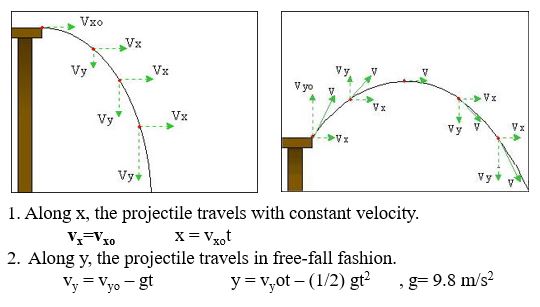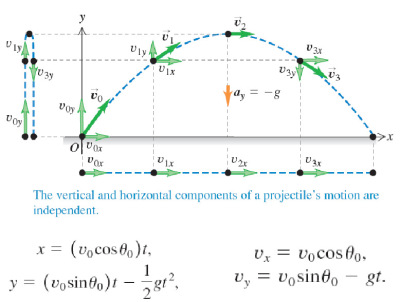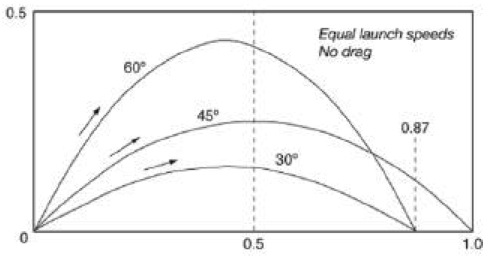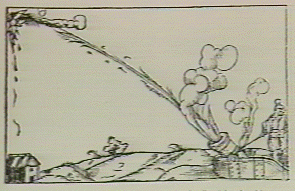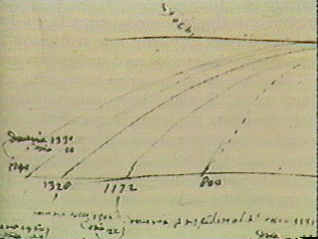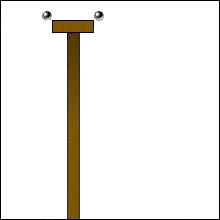Projectile Motion
claimed by Noah Llorens(Spring 2017)
This page will attempt to analyze projectile motion, a branch of classical mechanics in which the motion of an object (the projectile) is analyzed under the influence of the constant acceleration of gravity, after it has been propelled with some initial velocity.
The Main Idea
Two classic examples of projectile motion are the firing of a cannon and throwing a ball off a tower, but anything from passing a football to throwing a snowball at a friend are also examples of projectile motion. To be considered a projectile the only force which can be acting upon the object is gravity. Traditionally projectile motion is modeled from just after the moment a horizontal force ceases to act on the object till the object hits the ground or is otherwise interrupted. In this window of time the object’s motion can be modeled with constant, nonzero horizontal velocity and the constant force of gravity acting on the object.
A Mathematical Model
Regardless of the direction of motion of the projectile, upwards, downwards, rightwards, or leftwards, the free-body diagram of the projectile is still modeled as an object upon which only one force is acting, gravity. The resulting free body diagram is constant throughout the entire range of motion of the projectile. Thus, the free-body diagram of a projectile at any given moment would show a single force acting downwards and labeled force of gravity, more simply Fgrav, or mg (mass times gravity), the calculation of the force of gravity. The single, constant force is what gives us a parabolic curve, as the velocity is accelerating at a constant rate in the y direction and the velocity remains constant in the x direction.
[math]\displaystyle{ \vec{F}_{grav} = -mg\hat{y} }[/math]
where m is the mass of the projectile and
g represents the acceleration due to Earth's gravitational field.
ŷ is the direction of the force
A Computational Model
One method used to visualize or predict a projectiles trajectory is to apply our mathematical model using computational programming. Please see the following Projectile Motion Video for a detailed computational model including animation of a projectile in motion. For this computational model V-Python was used. One of the premises of computational programming is updating the forces acting on, momentum, and position of the objects in the model repeatedly in order to get an accurate representation of what the motion looks like as a whole. This is called iterative prediction of motion.
Examples
A projectiles trajectory, as discovered by Galileo, is modeled with a parabola. The cannon provides a very accurate representation of projectile motion because there is an initial force which has an X component (usually the cannon also has a Y component of force as well, but this is not necessary for projectile motion). This gives the ball the horizontal velocity needed to be a projectile.
You see here that the velocity of the ball can be broken into X and Y components which can then be analyzed separately as the projectile moves along its intended path. The X velocity is constant and the Y velocity accelerates with the force of gravity.
It is important to note that for this analysis we made many simplifying assumptions including, that the acceleration due to gravity remains constant because our object is very close to earth, its size is small enough to be modeled as a point mass where irregularities in shape can be neglected, also there are no resistive forces acting on our object that would affect its motion, such as drag.
Another important observation is that the angle of launch affects the distance which the ball travels. The same force applied at the 30, 45, and 60 degree angles yields three different curves of motion. Despite having different curves, each of the three curves are parabolas.
Connectedness
Understanding projectile motion was necessary for me to construct a Rube Goldberg machine which among other pieces contained a small catapult which launched a ping pong ball into a cup. To make the machine function properly I had to calculate the motion of the ping pong ball to place the cup in a position where it would catch said ball. One interesting industrial application of projectile motion is the creation of scopes for hunting rifles. A scope will usually have crosshair markings indicating the difference in distance of the animal from the hunter with the distance that the scope is calibrated to. This allows the hunter to aim more accurately at the animals he is hunting even if they are at a nonideal location. For example, if a hunter is 210 yards from a deer and his rifle is sighted for 200 yards he can aim at the deer with the dash on the scope which indicates +10 yards, or 10 more yards than his scope is sighted for. To find this distance, the scope makers must calculate the projectile motion of the bullet and determine how much higher to aim the rifle to hit a target 10 more yards away.
History
Major contributions to our current understanding of Projectile Motion
Aristotle
The first findings of Projectile Motion were contributed by Aristotle. He believed that a projectile modeled by a canon ball travels in a straight line until it lost its 'impetus'. When it lost its 'impetus' which ran out after time, due to a restive force, the projectile would immediately drop and fall to the ground. For objects projected over short distances, at first observation this can visually appear to be true.
Galileo
Galileo's findings were motivated by the Renaissance. At the time people were searching for a way to model 3-D objects in our 2-D world. Through as series of experiments he discovered that projectile motion is a result of Free Fall Motion along the y-axis and Uniform Motion along x-axis. This model is more well known and represents a more clearer understanding, one that is more widely accepted modern day.
Galileo proved that the vertical and horizontal motion of an object were unrelated. In other words, two objects will fall to the ground at the same rate if one is launched horizontally from the tower and the other object is simpy dropped. This is because each object has the same initial vertical velocity. Galileo also upended the beliefs of his time by proving that the curve of motion of a projectile was precisely parabolic.
Isaac Newton
Isaac Newton contributed to the idea of Projectile motion with his hypothetical cannon on a mountaintop. This hypothesis is now known as Newton's cannonball. Newton theorized that a cannon on top of a high mountain could fire a ball with varying forces for varying effects. A cannonball dropped off the mountain would merely return to earth, but if that cannonball were fired from a cannon then it would return to Earth in an arc, or parabolic shape. This would be considered projectile motion. Newton also extended this experiment to show universal gravitation, hypothesizing what orbit of the cannonball would look like.
See also
For more objects in motion see Curving Motion
External links
Interactive Projectile Simulator Projectile Simulator Horizontally-Launched Projectiles Angle-Launched Projectiles
References
The following references were used while writing this page:
https://www.phy.duke.edu/~rgb/Class/intro_physics_1/intro_physics_1.pdf
http://www.physicsclassroom.com/class/vectors/Lesson-2/What-is-a-Projectile
https://vidphysics.blogspot.ca/p/blog-page.html
http://blogs.umass.edu/ndarnton/2009/02/28/projectile-motion-in-biology/

